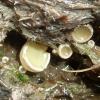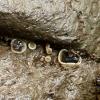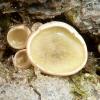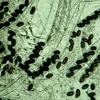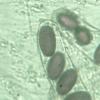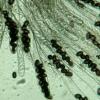
04-01-2026 17:45
 Stephen Martin Mifsud
Stephen Martin Mifsud
I was happy to find these orange asmocyetes which

03-01-2026 13:08
Niek SchrierHi all,We found groups of perithecia on a Lecanora

29-12-2025 17:44
Isabelle CharissouBonjour,J'aimerais savoir si d'autres personnes au

02-01-2026 17:43
MARICEL PATINOHi there, although I couldn't see the fruitbody, I

01-01-2026 18:35
Original loamy soil aside a artificial lake.The co

31-12-2025 19:27
Collected from loamy soil, at waterside (completel
Coprophilous Pezizaceae (2)
Esquivel-Rios Eduardo,
18-09-2012 21:18
Hans-Otto Baral,
18-09-2012 21:24

Re : Coprophilous Pezizaceae (2)
Dear Eduardo
I remember a big Ascobolus that I once found on horse dung in my garden. It was identified as A. scatigenus, but I never saw it again.
Here is the photo, and one from Panama by M. Piepenbring (left one) which I think might be the same species.
But it can well be that there exist several similar such species.
Zotto
I remember a big Ascobolus that I once found on horse dung in my garden. It was identified as A. scatigenus, but I never saw it again.
Here is the photo, and one from Panama by M. Piepenbring (left one) which I think might be the same species.
But it can well be that there exist several similar such species.
Zotto
Esquivel-Rios Eduardo,
18-09-2012 21:32
Re : Coprophilous Pezizaceae (2)
Yes, lokks identical, the inmature ascocarps cream-green and the mature black. Im chek Ascobolus.
Hans-Otto Baral,
18-09-2012 21:44

Re : Coprophilous Pezizaceae (2)
I remember that Meike said about the Panama fungus that the dark hymenia shoot their spores simultaneously upon touch or wind, thereby getting whitish within a blink of an eye! So the pale ones must not be immature.
Malcolm Greaves,
18-09-2012 23:45
Re : Coprophilous Pezizaceae (2)
I managed to capture this spore release if you are interested.
http://www.youtube.com/watch?v=ZvfVRfK83Oo?
Malcolm
http://www.youtube.com/watch?v=ZvfVRfK83Oo?
Malcolm
Hans-Otto Baral,
18-09-2012 23:49

Re : Coprophilous Pezizaceae (2)
Great! Is this real time or slow motion?
Malcolm Greaves,
19-09-2012 00:40
Re : Coprophilous Pezizaceae (2)
Real time.
Till Lohmeyer,
19-09-2012 16:34
Re : Coprophilous Pezizaceae (2)
It may well be Ascobolus scatigenus. There are hardly any other Ascoboli reaching that size. I've seen it quite frequently on horse dung in Australia. It seems to prefer the tropics or at least warmer regions. @ Zotto: I don't know of any other German find. What a garden!
Regards, Till
Hans-Otto Baral,
19-09-2012 16:40

Re : Coprophilous Pezizaceae (2)
Hi Till
It was dung from our neighbors, who keep horses. Possibly there was some inoculum introduced from the tropics, otherwise I cannot explain. Sometimes I think I have also introduced some fungi into my garden through specimens sent to me. But this Ascobolus was long before Guy made his trips to Australia...
Zotto
It was dung from our neighbors, who keep horses. Possibly there was some inoculum introduced from the tropics, otherwise I cannot explain. Sometimes I think I have also introduced some fungi into my garden through specimens sent to me. But this Ascobolus was long before Guy made his trips to Australia...
Zotto



